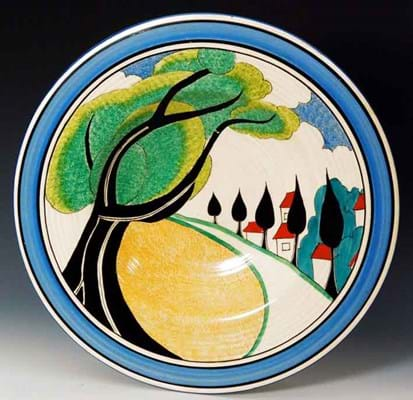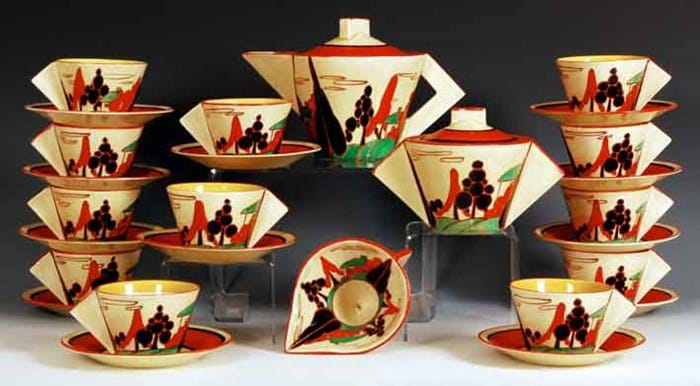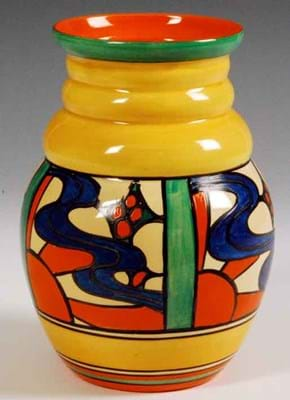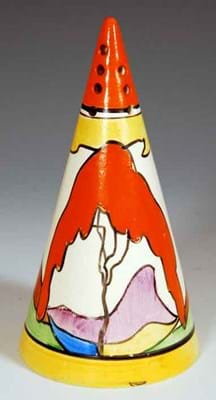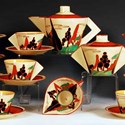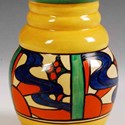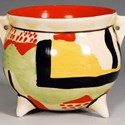A decade ago the Clarice Cliff market had really 'taken off'.
Staffordshire's most famous exponent of the Art Deco enjoyed rise-upon- rise into the 1990s, and the appearance of a truly iconic piece at Christie's South Kensington in May 2003 ushered in a remarkable auction record. The £34,000 tendered for a 'unique' charger in the coveted May Avenue pattern was almost double the previous high (£18,000 bid in December 2001 at Phillips for a Windmill pattern charger) and remains the high watermark for Clarice at auction.
But since those heady days, the Clarice Cliff market has lost some of its biggest bidders, its annual South Kensington showpiece sale and its erstwhile reputation as a solid investment. It's no bad thing for those collectors who were previously priced out of the market, but negative price readjustments are never as easy to digest as the positive ones.
When leading collector Sevi Guatelli turned vendor in March to sell his 'Iconic Clarice Cliff' collection at Bonhams, it was difficult to avoid the conclusion that prices for even the best Clarice are down 50 per cent or more on previous highs.
How much would a May Avenue charger be worth today? Surprisingly, Fieldings of Stourbridge were offered the opportunity to answer that question at their third Clarice Cliff Collectors' Club sale on May 30.
It was late last year when specialist Will Farmer received an email titled simply Clarice Cliff Valuation. It's not an unusual request for a man who began his personal Clarice Cliff odyssey as a member of the CCCC aged 14, but a digital image unquestionably revealed another 18in (46cm) ribbed charger in the May Avenue pattern. It had been bought new (c.1933) by a forebear of the owner and, despite years under a table-tennis table, it had survived in fine condition with only two small paint flakes and a number of faint small linear scratches to its detriment.
Nothing close to £34,000 was expected this time round (for a start, there are now four known examples and a smaller pool of potential buyers) and Mr Farmer was content to suggest an estimate of £20,000-25,000. It proved spot-on when a dealer bought it on behalf of a client at £20,500.
There were two other pieces of May Avenue in the sale, an 11in (23cm) high Greek shape jug (estimate £3000-3500) and an 8in (20cm) waisted vase (estimate £4000-6000), but both failed to sell. An example of the latter had made £4500 at the Guatelli sale.
But when estimates were keener, so was the competition. Many of the 100-120 'Cliffies' in the room at Fieldings would have liked to acquire a cauldron vase decorated in the Sunspots pattern c.1931 within its estimate of £400-600 - a modest sum for a rare piece with just two minor paint scuffs.
The 11 pieces in this scarce pattern offered by Sevi Guatelli at Bonhams carried much higher estimates and eight panels of abstract design. This transitional piece from the Original Bizarre range probably dates from c.1928-29.
A buyer was also found at the low estimate of £3000 for an Inspiration Persian wall plaque c.1930-31.
Decorated with an Isnik-inspired scroll and foliate pattern in tonal turquoise, blue and ochre, the scale and execution of this charger indicate that it may well have been intended as an exhibition piece, perhaps in South Africa where this pattern was originally exported. There were 21 conical sugar sifters in the sale and, with some latitude on the part of the auctioneer, all of them sold.
It was a much better return than seen at Gardiner Houlgate of Bath in November when just 26 of a 68-lot collection of sifters got away.
Pricing and good condition was again the key: all the examples mentioned here were undamaged.
At £1800 (the estimate was £2000- 2500), the most highly rated sifter was in the Mountain pattern. It was a very strong, well-painted example, with a larger than usual mountain and cottage. From the same year and the same Fantasque range is Summerhouse, a quirky pattern originally made for the South African market.
The sifter in this pattern, only the third of its kind to come on the market, sold at £900. Sifters in the striking Green Erin design, c.1933, (£630), Red Gardenia, c.1933, (£1000) and Flower Wave, c.1934, (£920) also sold solidly.
Lower down the price scale the market was weaker than at Fieldings' two previous Clarice events, but collectors appreciate the breadth of these sales that offer plenty in the £30-300 price bracket. There were new buyers at this sale including contributions fromNorth America and Australia.
Some of the best entry-level pieces on offer, all undamaged, included: an Umbrellas pin dish (£80); a small conical jug with rust-red banding, c.1936, (£38) and an Original Bizarre tazza, c.1928, painted to the interior well with a radial abstract pattern (£75).
The buyer's premium was 15%


